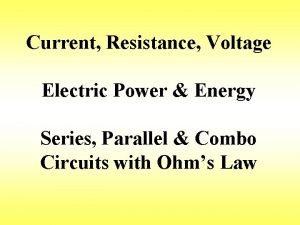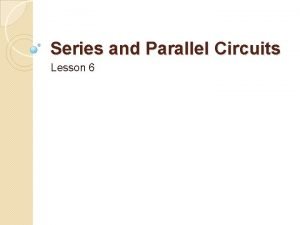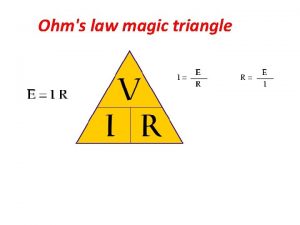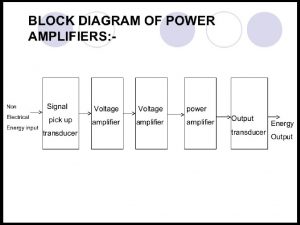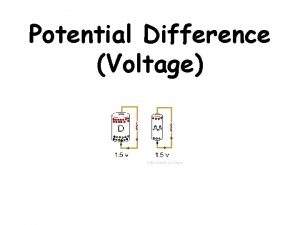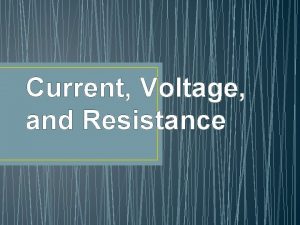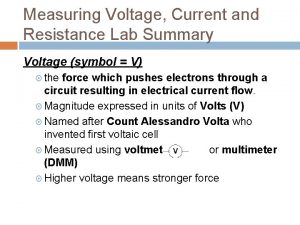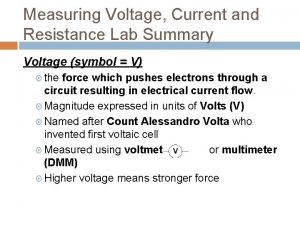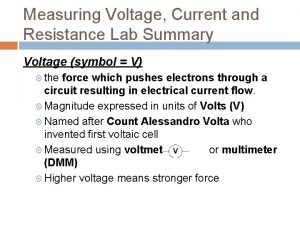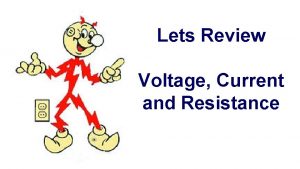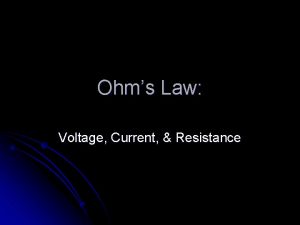Potential Difference Current and Resistance Voltage Current Resistance












- Slides: 12

Potential Difference, Current and Resistance • • Voltage Current Resistance How to Measure Voltage, Current and Resistance

Potential Energy = the energy stored in an object • Every electron has potential energy

Potential Difference or Voltage (V) = The source of energy in a circuit provides energy to the electrons. Voltage is described as the force that moves electric charges in a circuit. It is how much energy that the electrons pick up from the source.

Measuring Potential Difference Volt (V) – is the unit used to measure potential difference Voltmeter • Measures the potential difference between two locations in a circuit • A voltmeter is connected in parallel

Electrical Current = is the number and speed of the electrons that are moving through the circuit.

Measuring Current The electric current is measured in units called – Ampere (A) The symbol for current is I Ammeter- measures current in a circuit. An ammeter is connected is series.

Resistance Electrons are very small particles. They move very quickly through a circuit but can sometimes be slowed by larger objects that get in their way (like the nuclei of atoms). The ability to slow the movement of electrons in a circuit is called Resistance. ALL SUBSTANCES RESIST ELECTRON FLOW • Conductors have low resistance values • Insulators have high resistance values

The loads in a circuit tend to have high resistance, to slow the electrons and convert the energy into a useable form of energy. • A Light Bulb Filament has a high resistance.

Resistors • Resistors can be used to control current or potential difference in a circuit • The amount of resistance in a circuit affects the electrical current – Current decreases if you add resistance

Factors Affecting Resistance Table 11. 1: Page. 443 Factor How Factor Affects Resistance Material • The material used in a circuit effects the resistance on the circuit • Copper is used most frequently as conducting wire Temperature • High temperatures have a higher resistance • Low temperatures have a lower resistance Length • Longer wires have more resistance • Shorter wires have less resistance Cross-sectional Area • Wide wires have less resistance • Short wires have more resistance

Measuring Resistance Ohm (Ω) – the unit used to measure resistance The symbol for resistance is R Ohmmeter • Measures electrical resistance

Homework A. Questions 3 -5 pg. 438 B. Questions 1 -3 pg. 442 C. Questions 3, 4, 5, 7, 8, 10 pg. 447
 Current potential difference and resistance
Current potential difference and resistance Line current and phase current
Line current and phase current Find current in parallel circuit
Find current in parallel circuit Lesson 6 current voltage and resistance in a circuit
Lesson 6 current voltage and resistance in a circuit Voltage current triangle
Voltage current triangle Difference between voltage amplifier and power amplifier
Difference between voltage amplifier and power amplifier Define electric potential and potential difference.
Define electric potential and potential difference. Electric potential energy
Electric potential energy Difference between sales potential and market potential
Difference between sales potential and market potential Electric potential inside non conducting sphere
Electric potential inside non conducting sphere Potential of conductor
Potential of conductor Electrical potential
Electrical potential What is the objective of earthing or grounding
What is the objective of earthing or grounding


